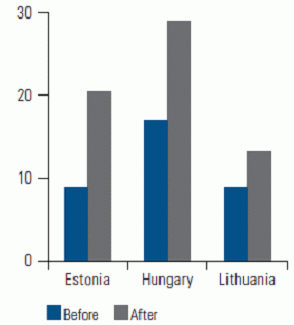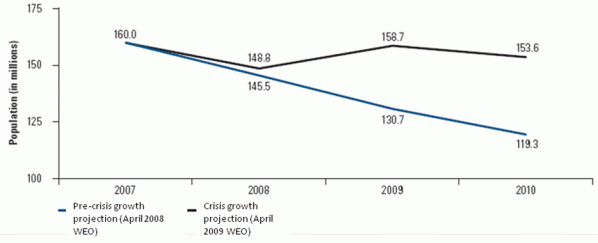Over the recovery period following the 1998 Russian crisis, some 50 million people moved out of poverty in the economies of Eastern and Central Europe, the Former Soviet Union and Turkey which make up the World Bank’s Europe and Central Asia region (see World Bank 2005 for analysis). Poverty fell throughout all the sub-regions of Europe and Central Asia led by the populous middle-income countries of the Commonwealth of Independent States (CIS). Such a massive reduction in poverty was driven by rising incomes everywhere, particularly through rising real wages among the working poor.
The global financial crisis, which has led to a sharp slowdown in regional economic activity, now risks reversing the substantial gains and improvements in living standards of the last few years. Countries are facing a number of major and interrelated economic shocks. The first is the global slowdown leading to lower export revenues (Freund 2009). In addition, remittance inflows to low-income countries such as Moldova and Tajikistan have fallen. Meanwhile, the crisis drastically reduced the availability, and increased the cost, of external finance across public, corporate and financial sectors. Finally, as commodity prices fell, commodity-exporting countries suffered.
Poverty gains over the last decade are at risk of reversal
In recent research (World Bank 2009), we use pre-crisis household data along with aggregate macroeconomic outturns in these countries to simulate the impact of the crisis on households. We find that the crisis threatens the well-being of close to 40 million poor people. It also threatens the welfare of an additional 120 million people who are living just above the poverty line and at risk of easily falling into poverty as economies contract.
The crisis is hitting households on multiple fronts
We analyse three main transmission channels from macro shocks through to households: access to financial markets (including the cost of borrowing and the burden of debt service payments), the relative prices of goods and services, and, income and employment. Our focus on these mechanisms reflects lessons from analysing the social effects of crises over the last three decades as well as data availability constraints. However, we do ignore several important elements such as wealth effects associated with changing values of property and equity holdings (including pensions), the second-round effects of the crisis and the combined consequences of multiple shocks. The role of government policy and social assistance is also not addressed explicitly in the quantitative analysis. Government policy can, in fact, either dampen the impact of shocks or worsen them, depending on how such policies are formulated and implemented.
Analytical approach
The report analyses household vulnerabilities by examining credit markets, external prices (food and fuel), and income shocks during the crisis and by assessing their impact on household welfare. Because actual household survey data over the crisis period will typically not be available for some time to come, we use the most recent pre-crisis household data along with aggregate macroeconomic outturns to simulate the impact on households of key economic shocks already taking place. The impact on household well-being is quantified as the change in the household debt service burden, the fall in real income, or movements into poverty, as appropriate. The microeconomic simulation in the report draws on a large, cross-country database of household surveys, bringing together for the first time comparable data on household indebtedness for a large group of European and Central Asian countries using the EU Survey of Income and Living Conditions and Household Budget Surveys.
Many households will risk defaulting as debt service obligations rise
The rapid rise in household access to credit – in the new EU member states as well as in some Western Balkan countries, such as Albania and Serbia, and CIS countries such as Ukraine – has both brought benefits to households and exposed them to potential credit market shocks. Borrowing allows households to smooth their consumption, purchase durable goods, and invest in housing. However, because of the specific characteristics of household loans in the region, this rise in indebtedness (Figure 1) means that payment obligations can increase very sharply when shocks are realised. First, many households borrowed in foreign currency, exposing the local currency value of their payment obligations to exchange rate depreciations (Figure 2). Second, many households have loans that have variable interest rates. In addition, those who have recently lost their jobs will have an even more difficult time meeting their payment obligations.
Figure 1. Household debt
Figure 2. Foreign currency exposure
The results of the stress tests on household loans suggest that the adverse effects of the crisis on households are widespread1. Both poor households and non-poor households may be affected depending on the shock, transmission channel, and household characteristics. The share of vulnerable households or borrowers at risk (as a percentage of all indebted households) will grow (see the unemployment shock example in Figure 3). Although the share of indebted households and households at risk in Europe and Central Asia region still lag behind those of richer countries, the aggregate effects of rising debt service burdens are already seen in rising household loan delinquency rates.
Figure 3. Share of vulnerable households or borrowers at risk after an unemployment shock
Source: EU-SILC data and World Bank staff calculations. Note: The simulated shock is a 10-percentage point increase in unemployment rates. This refers to mortgage debt only. Vulnerable households are identified using a 20% interest payment threshold. See World Bank (2009) for more details.
In some countries, food and fuel prices will rise as the value of currencies fall with the poorest consumers again vulnerable
Global food and fuel prices have fallen from their highs of 2008 but international commodity price levels have not returned to pre-2007 levels. Specialists have also pointed to longer-term challenges in global food production that are yet to be addressed. In addition, falling currencies in some countries resulted in a new round of price increases, depending on the share of imported food and fuel in local consumption and the degree of exchange rate pass-through. Finally, in a number of countries such as Belarus, Moldova, and Ukraine, the utility reform programme remains largely incomplete. As a result, for reasons of economic efficiency or fiscal consolidation, a number of countries will have to adjust their energy tariffs to cost-recovery levels in the coming years.
The impact on households of a food or fuel price crisis is not straightforward. The experience with the recent food price crisis, for example, tells us that the net effect of a rapid food price increase depends on whether households are net producers or net consumers of food, it depends on how much food they consume and whether there are cheap substitutes, and it depends on their sources of livelihood and their ability to take advantage of profitable opportunities in agriculture. These considerations suggest that, at least in principle, the poor are not necessarily the hardest hit. However, food represents a very large share of the poor’s total consumption. In low-income countries of the region, the food share of consumption among the poor is 80%. Moreover, in reality, the poor are the worst hit, as many of the poor in Albania, Kyrgyz Republic, and Tajikistan, for example, are also observed to be net consumers, with limited access to agricultural assets and inputs.
Rising poverty due to employment and income shocks
The poverty impact of the regional recession will be enormous (see Chen and Ravallion 2009). The results of simulations suggest that by 2010, there will be 11 million more people in poverty and over 23 million more people just above the international poverty line, relative to pre-crisis projections for growth and poverty. (These calculations are based on a comparison of the poverty simulations for 2010 using the April 2009 IMF World Economic Outlook projections for growth with those using pre-crisis projections from the April 2008.)
The growth in poverty would represent a fifth of the region’s population who recently moved out of poverty. This is not surprising given that regional poverty is shallow, with many individuals susceptible to falling into poverty even with modest falls in average income. Alternatively, one could think of them as the recent-poor, with fragile links to the labour market, little savings, but benefited from recent credit and construction booms.
Figure 4. Population living under $5-a-day 2007-2010
Source: IMF WEO databases and World Bank Staff calculations.
The magnitude of the estimated poverty impact varies by sub-regions (Figure 5). The middle-income CIS countries, on average, have seen the largest and most significant downward revisions to their GDP growth projections. As a result, they are also seeing the largest percentage-point increases in the projected poverty headcount. They are followed closely by the low-income CIS. The overall results mask the variety of possible effects within countries, including the concentration of the poverty impact in selected economic sectors. Country studies recently completed suggest that for economic shocks transmitted mainly through the labour market, poverty will rise especially among households that have been dependent on remittance inflows and those previously employed in booming construction sectors where economic activity is now projected to decline sharply.
Figure 5. Percentage point change in poverty and vulnerability in 2010 under crisis versus pre-crisis growth projections
Note: Rise in poverty in% of population when calculated using April 2009 WEO growth projections for 2010 relative to when calculated using pre-crisis April 2008 projections. Source: IMF WEO databases and World Bank Staff calculations.
Coping with the crisis and policy response
In some ways, our simulated effects outlined above may be an understatement – they only capture a subset of the first-round effects. Second-round effects on access to education, health and social services, in particular, can be significant. How can households protect themselves? In the current regional downturn, the scope for households to engage in their traditional coping strategies, such as secondary employment or migration, may be limited. This means that the policy responses to the crisis are critical.
However, in many countries the immediate fiscal policy response has been constrained by rapidly falling revenues. Many countries have substantial government deficits and, in the absence of new financing sources or limited scope to mobilise revenues, may resort to across-the-board cuts in spending. Such blunt adjustments will likely substitute for efforts to improve the efficiency of public spending. Although social safety nets will be among those items likely to be cut as revenues fall, protecting these programmes – and possibly expanding some of them, where some reallocation of resources are possible – is an important element in the response to the crisis. The region’s social protection systems currently vary in size and targeting performance and as a result the response to the crisis can involve expanding some well-performing programmes, reforming relatively less effective interventions or, alternatively, introducing new programmes as appropriate. In the context of constrained fiscal resources, the prioritisation of labour-using investment expenditures could also be one option for addressing the labour market consequences of the crisis.
Note: These are the views of the authors and should not be attributed to the World Bank or any affiliated organisation.
References
Chen, Shaohua and Martin Ravallion (2009), “The impact of the global financial crisis on the world’s poorest”, VoxEU.org, 30 April.
Freund, Caroline (2009), “Demystifying the collapse in trade”, VoxEU.org, 3 July.
Holló, Dániel (2007), “Household indebtedness and financial stability: Reasons to be afraid?”, MNB Bulletin, November (Budapest: National Bank of Hungary).
Johansson, Martin W and Mattias Persson (2006), “Swedish households’ indebtedness and ability to pay: a household level study”, Sveriges Riksbank Economic Review, No.3: 24-40.
International Monetary Fund (2009), World Economic Outlook, April.
World Bank (2009), The Crisis Hits Home: Stress Testing Households in Europe and Central Asia, Washington DC (core team led by Erwin R Tiongson and including Anna I Gueorguieva, Victoria Levin, Kalanidhi Subbarao, Naotaka Sugawara, Victor Sulla, and Ashley Taylor)
World Bank (2005), Growth, Poverty, and Inequality: Eastern Europe and the Former Soviet Union (Washington: The World Bank)
Żochowski, Dawid and Slawomir Zajączkowski (2008), “Stress testing household indebtedness: impact of financial vs. labour market shocks”, World Bank Workshop, Macro Risks and Micro Responses.
1 The analysis follows some recent attempts to stress test household debt holding and assess the share (or change in share) of vulnerable households. See for example Holló (2007), Żochowski and Zajączkowski (2008), Johansson and Persson (2006), and others.











